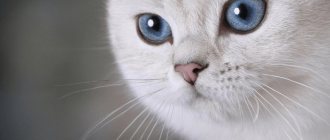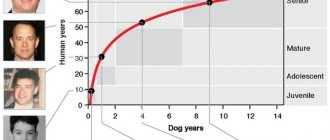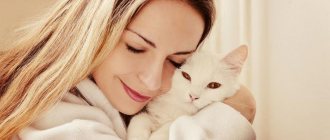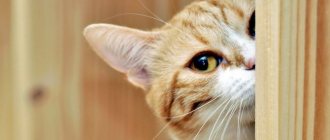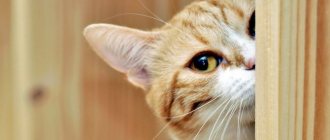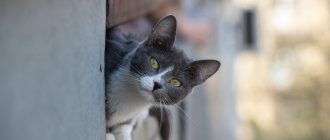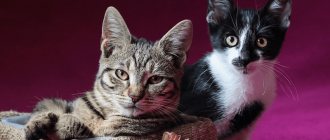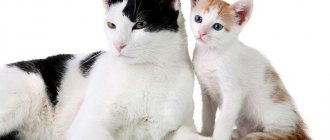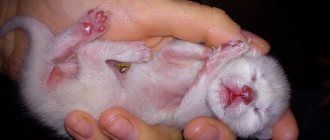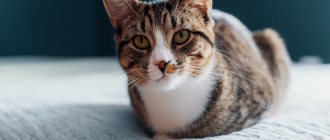Cat to human age ratio
There is no clear linear relationship between cat and human age, so it is difficult to calculate how many human years a cat has.
An approximate conversion of a cat's age to a human age is presented in the table. Table 1 - Comparison of the ages of cats and humans
| Age periods | Cat | Human |
| Childhood | 1 month | 6 months |
| 2 months | 10 months | |
| 3 months | 2 years | |
| 4 months | 5 years | |
| 5 months | 8 years | |
| 6 months | 14 years | |
| 7 months | 15 years | |
| 8 months | 16 years | |
| Youth | 10 months | 17 years |
| 1 year | 18 years | |
| Youth | 2 years | 25 years |
| 3 years | 30 years | |
| 4 years | 35 years | |
| Maturity | 5 years | 40 years |
| 6 years | 43 years | |
| 7 years | 45 years | |
| 8 years | 50 years | |
| 9 years | 55 years | |
| 10 years | 60 years | |
| Elderly age | 11 years | 62 years old |
| 12 years | 65 years old | |
| 13 years | 68 years old | |
| 14 years | 72 years old | |
| 15 years | 74 years old | |
| Senile age | 16 years | 76 years old |
| 17 years | 78 years old | |
| 18 years | 80 years old | |
| 19 years | 90 years old | |
| 20 years | 100 years |
Calculation using specialist observations
Many experts are inclined to believe that during the first five years, each year a cat lives is equivalent to 7 human years.
- From 6 to 12 years old, each year a pet lives can be counted as 4 human years, and after 12 years as three human years.
- Using this calculation, we find that an 8-year-old cat lived 5 x 7 + 2 x 4 = 43 years by human standards.
Life stages of cats
In cats, it is customary to distinguish three main stages of life - childhood and adolescence, youth and maturity, old age and old age. During these periods, the animal’s behavior and its relationship with the outside world change.
Childhood and youth
Childhood and adolescence are a period of learning useful skills and learning about the world. During this period, animals are especially active and energetic. By the age of two months, kittens develop normal coordination of movements, they feed independently and know how to use a litter tray. 2-3 months is the optimal age for handing over babies to new owners. Puberty begins at 4-6 months. By the age of one year, cats become fully grown, capable of obtaining food by hunting and bearing offspring. During childhood and adolescence, animals are still inexperienced, but curious, active and fearless, susceptible to infections, so at this stage you should create the safest possible living environment for them.
Youth and maturity
Young cats retain their youthful excess of energy and continue to gain life experience. During this period, the immune system finally matures. From 3-5 years old, animals become calmer, although they are not averse to playing with their owner and spend a lot of time hunting (including inanimate objects). Their regime is measured - food, entertainment and rest on a schedule. Cats are usually more self-sufficient; cats are more attached to their owner. This is the heyday of cat life, procreation.
Elderly and senile age
Elderly cats are calm and complacent; they like to be alone and sleep. These are wise animals that understand the person they love and trust perfectly. They are more conservative and often react to changes in the environment with stress and irritation. During this period, the immune response and the ability to thermoregulate weaken – the pet becomes sensitive to infections and does not tolerate heat and cold well. Elderly animals often react painfully to the arrival of a new pet in the house. At the end of its life, a cat needs to be protected from any changes and stress, and given enough attention.
Staying active
It has been noticed that cats who lead a “sofa” lifestyle live much shorter. This is due to the fact that the pet begins to develop obesity. For this reason, the cat must be forced to move, especially at a young age.
To do this, it is worth acquiring special toys and complexes. It is also useful to play with your pet on your own. And some breeds can also be walked regularly
Pay attention to your pet - both you and he will enjoy a fun time
You should not let your cat out of the house on your own, this can lead to the most unpredictable results: dogs will attack, a car will hit you, the animal may contract some kind of disease. Visiting the street is only under the strict control of the owners.
How to determine the age of a cat by external signs
It is extremely difficult to determine the age of an adult cat by its appearance. Often animals of very advanced age do not look decrepit and weak. If the age of the new pet is unknown, you can try to find it out using the following parameters:
- Teeth. The only reliable criterion for determining age is the appearance and change of teeth - useful only for kittens. At 2-3 weeks, babies develop incisors, at 3-4 - canines, at 3-6 - premolars. Then, at 3-4 months, the incisors change, and at 4-6 months, the remaining teeth. By 7 months, the change of teeth is completed. After 1-1.5 years, a yellowish coating appears on the surface of the teeth, which becomes more intense over the years. Age-related tooth loss is an individual factor: some 16-year-old cats can boast a fully “complete” toothy mouth, and in some, dental diseases accompanied by tooth loss occur as early as one year of age.
- Wool. Until old age, healthy cats have a smooth and shiny coat and a dense undercoat. Then the undercoat thins out and the coat becomes less smooth. In long-haired animals in old age, a decrease in the volume of the tail due to wool is clearly noticeable. After 8-10 years, individual gray hairs may appear (total graying, as in humans, does not occur in cats). In old people, the fur becomes dull, the mustache thins and shortens.
- To the eyes. Up to 1-2 years, cats will retain “kitten” curiosity and enthusiasm in their eyes, even during rest. Older individuals look at the world more calmly and lazily. After 10-12 years, the eyes begin to gradually “sink”, but their clarity remains until old age, if the pet is healthy.
- Conditions. The body of young cats feels soft and plastic, and after 5 years it becomes denser, as if “hardening” (which does not in any way affect their dexterity). After 8-10 years, the contours of the cheeks, chin and body become less rounded. In old age, the muscular system and fat layer undergo dystrophic changes, the animal loses weight and “shrinks out.”
- Musculoskeletal system. The condition of the musculoskeletal system in cats changes little over the years, so gait practically does not change with age, and the ability to jump high remains in old age. Joint stiffness with a noticeable decrease in physical activity is typical in old age
A veterinarian can more accurately determine the age of a cat by examining the fundus of the eye or by the condition of the internal organs during surgery.
Table of maximum life expectancy by breed
The Guinness Book of Records contains many records for life expectancy in cats. However, for most pets, some pattern can be deduced.
| Maximum age (years) | Cat breeds |
| 20 |
|
| 19 |
|
| 18 |
|
| 17 |
|
| 16 |
|
| 14 |
|
Long-lived cats
Famous cats and cats - record holders for life expectancy:
- Lucy the cat – 39 years old (born in 1972, the record was registered during the cat’s lifetime in 2011), South Wales, UK
- Cat Cream Puff – 38 years old (1967-2005), Texas, USA
- Baby Cat – 37 years old (1970-2007), Minnesota, USA
- Cat Granpa Rex Allen - 34 years old (1964-1998), Texas, USA
- Scooter the Cat – 30 years old (1986-2016), Texas, USA
In the photo, the long-lived cat Cream Puff
There is no relationship between the breed of a cat and its lifespan. Representatives of indigenous breeds (Norwegian Forest, Siberian, Maine Coon) were distinguished by good health and longevity until they were affected by mass artificial breeding.
Table of average life expectancy by breed, features and diseases
| Breed | average life expectancy | Characteristic diseases and features |
| Persian | 15-20 | “Exotics” live longer than the “classical” and “extreme” Persians.
|
| Siamese | 15-20 | “Purebreds” are more likely to develop diseases than mixed breeds; there may be problems with the kidneys and eyes.
|
| British | 12-15 |
They rarely suffer from cancer, have good immunity, it is important to maintain an active lifestyle and feed them with high-quality food. |
| Scottish Fold (Scottish Fold) | 15-20 |
They have good immunity, but it is important to choose the right diet to maintain the cat’s vital activity. |
| Siberian | 15-17 |
However, 25 years is not the limit for a “Siberian” if you keep your pet properly, since it has no tendency to develop genetic diseases. |
| Russian blue | 12-16 | A domestic cat can live longer with care and affection if it is regularly shown to a veterinarian and its nutrition is properly organized.
|
| Abyssinian | 15-17 |
It is important to regularly monitor your pet's health and take your pet to the veterinarian. |
| Bengal | 12-15 |
One of the strongest and hardiest breeds, it is only important to feed and care for them correctly. |
| Sphinx | 12-15 |
With the right approach to maintenance, it can live more than 20 years, and even at such a respectable age it has excellent immunity. |
| Maine Coon | 14-16 |
|
Maine Coon
How to extend the life of a cat
The following factors influence a cat's lifespan:
- Self-walking. Vagrancy should be avoided; in urban conditions, letting a cat out of the house unattended is doubly dangerous. Such walks often end in injury, incurable infection (viral leukemia, immunodeficiency) and death. It is better to fence the dacha area so that the cat cannot leave its boundaries, or equip it with a spacious enclosure.
- Nutrition. The diet should be fresh, balanced, and appropriate to the age of the animal. Industrial feed should be chosen at least premium class. If ready-made food is not suitable for some reason, the cat should be prepared separately; you should not feed it food from the human table.
- Regular vaccination. It is necessary to vaccinate all pets, including those who do not leave the house (the causative agent of the infection can come from the outside, from the owner’s shoes or clothes).
- Control of reproduction. It is best to neuter your pet. In fertile cats, do not give birth more often than once every 1-2 years (at the age of no earlier than 2 years and no later than 6-7).
- Veterinary control. At the first sign of illness, your pet should be seen by a doctor. For older cats, an annual preventive examination is recommended, including a general examination, blood, urine and feces tests, and consultation with a cardiologist.
- Living conditions. The cat should have a resting place in the house, where no one will disturb it, and enough toys for active pastime. The litter tray must be placed in a secluded place and kept clean.
Compliance with the rules of keeping, love, creating a calm and friendly atmosphere in the house is the key to a happy and long life for your pet.
Factors influencing health and longevity
According to experts, the quality of life of an animal directly affects its duration.
- Genetic properties of the breed. All breeding groups are divided into 3 categories - long-lived (maximum age 15 years or more), medium-lived (10-15 years) and the lowest level (less than 10 years). How long they live depends on the circumstances - among stray animals there are also long-livers.
- Conditions of detention. The reasons for the reduction in life expectancy of cats may be an unsatisfactory living environment, for example, when the animal does not receive the necessary veterinary care.
- Nutrition. A high-quality diet and properly selected mineral and vitamin components can add a couple of active years to the life of domestic cats.
- Disease prevention. Each breed has a predisposition to certain ailments, and almost all cats also have heart and kidney problems. When neglected, these diagnoses are no longer curable and become chronic. Even young animals are not able to constantly cope with the resulting load and painful sensations. Such cats do not live long.
- Emotional background. The most subjective indicator, but many owners believe that life expectancy is influenced by the attitude of owners and family members, friendship with other four-legged pets, degree of training, general games and walks.
Adopt not a kitten, but an adult cat
So it's no surprise that the stereotype of the "old" 10-year-old cat is becoming a thing of the past. People notice that with responsible handling, treatment, and quality nutrition, such cats, and even older ones, will live for many more years. And their calm disposition, independence, wisdom and at the same time affectionate affection for the owner attract many people, especially those who cannot support the kitten’s hyperactivity. Therefore, in “Murkosh” such cats also quickly find an owner.
If you want a calm, independent pet, come to our shelter and take a closer look at them - perhaps you will find exactly the one you were looking for!
Childhood (3-4 – 6 months)
A kitten, like a child, actively explores the world and reaches out to its elders (keep in mind that the owner is like a parent for a kitten). Physically, he is growing very quickly, and his irrepressible energy and thirst to explore everything around him require active action. On the one hand, this is a very interesting period for observing a kitten - every day will bring something new. On the other hand, it’s not for nothing that they say that disadvantages are the other side of advantages (as well as vice versa). All this is very good if you or someone in your family are willing to devote a lot of time to the kitten (at least several hours a day): for play, for feeding 6-7 times a day, for frequent visits to the veterinarian (like children, kittens often get sick). You need to be prepared for sleepless nights (however, active games during the day will allow you to sleep better), for overturned things (and, if you are careless, broken), and for the fact that the kitten will require a lot of attention. If you are not ready for this, if you don’t have time for this, then you yourself will miss such an interesting stage in your pet’s life, and you will make him unhappy, perhaps even jeopardizing his health. Or the kitten will simply find something to do alone, and you will be angry about the disorder in the apartment and, in the worst case, decide to part with it.
To avoid all this, if you have a shortage of free time, we recommend that you take an adult pet - it is calmer and more independent and can tolerate loneliness more easily.
Read more: Adopting an adult cat is not a problem!
